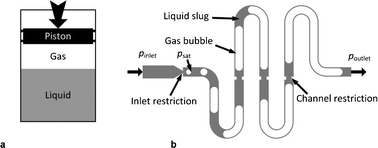Determining phase diagrams of gas–liquid systems using a microfluidic PVT†
Abstract
A novel microfluidic device designed for analyzing phase diagrams of gas-liquid systems (PVT or pressure-volume-temperature measurements) is described. The method mimics the phase transition of a reservoir fluid as it travels through the wellbore from the formation to the surface. The device consists of a long serpentine microchannel etched in a silicon substrate. The local pressure inside the channel is measured using membrane-based optical pressure sensors positioned along the channel. Geometrical restrictions are placed along the microchannel in order to nucleate bubbles when nucleation conditions are met, thus preventing the development of a supersaturation state in the channel. We point out that a local equilibrium state between gas and liquid phases is achieved, which implies that equilibrium properties can be directly measured on the chip. We analyze different mixtures of hydrocarbon systems and, consistently with the preceding analysis, obtain excellent agreement between our technique and conventional measurements. From a practical viewpoint (important for the relevance of the technology), we observe that the measurement time of thermodynamic properties of gas–liquid systems is reduced from hours to minutes with the present device without compromising the measurement accuracy.


 Please wait while we load your content...
Please wait while we load your content...